ROCKY GIBBS AND HIS WILDCATS
by Wayne van Zwoll
Hot-rodding the .30-06, this Idaho wildcatter claimed speeds that sent handloaders to their presses and challenged P.O. Ackley’s Improved dynasty!
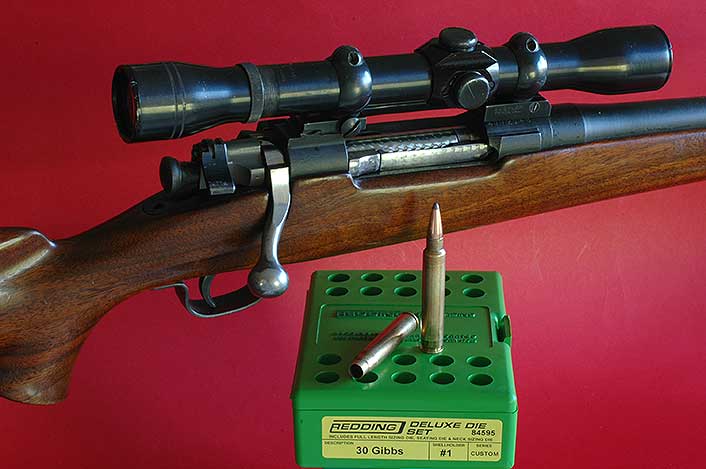
IN A GUN-SHOP not long ago, I picked up an 03A3 Springfield dating, I reckoned, to the 1960s. The barrel was original, minus the front sight. Beuhler rings clenched a Weaver scope branded J.C. Higgins. Simple but not crude, the sporting stock was of plain walnut, with the ventilated pad of the period. Tightly inletted and well finished, the wood cradled my cheek and led my eye to the crosswire. Barrel inscription: “.30 Gibbs.” The proprietor willingly obliged an offer. He smiled as I left with a rifle old enough to draw Social Security, re-chambered for a cartridge few hunters have even heard of.
But I had. In fact, Rocky Gibbs lived not far from my current digs. He was a pioneer in an era of pioneers who gave us fast, flat-shooting cartridges – men whose experiments and time at the bench and on the mountain shaped the modern hunting rifle. The old Springfield in my hand was a piece of history….
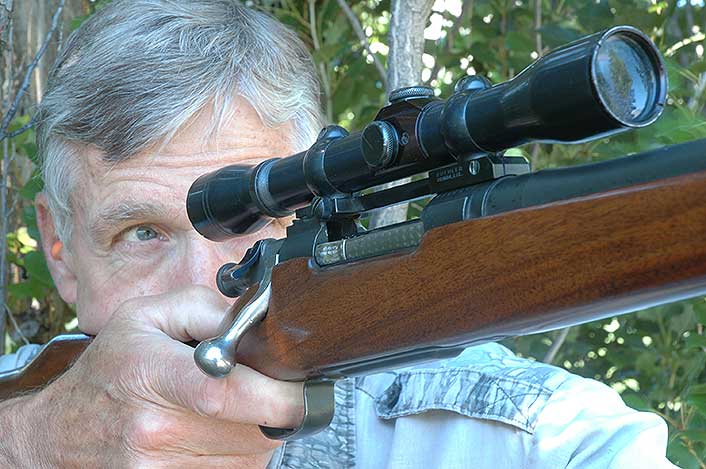
DURING a March snowstorm in 1955, rifle-maker Rocky Gibbs moved from Richmond, California to Viola, Idaho, where he’d bought a 35-acre tract laid out to accommodate a 500-yard rifle range. In his shop, Rocky re-established Gibbs Rifle Products and expanded a series of cartridges on the .30-06 case with the shoulder moved forward. Fashioning a Gibbs hull, handloaders had to create a false or temporary shoulder with dies to maintain headspace before fire-forming. Or they could spring for the Rocky Gibbs Wildcat Case Forming Tool, a hydraulic press, to help with this operation.

Even before his Idaho move, Rocky had hot-rodded his Remington 721 in .270, dismissing P.O. Ackley’s Improved 40-degree shoulder at the original shoulder location. A Keith Francis reamer that cut a long chamber with a 35-degree angle to a .250 neck yielded the .270 Gibbs. Evidently Rocky set a record with this cartridge at a Richmond match in 1953. The following year, he would add six more cartridges to a proprietary stable that would change little over the next couple of decades.
The .240 Gibbs, most easily formed from .25-06 brass, is among the most enduring of Rocky’s wildcats – though he made relatively few rifles so chambered. He recorded over 3,600 fps with 75-grain bullets, 3,500 with 85-grain bullets and 3,250 with 105-grain Speers. Rocky hailed the .25 Gibbs as the only wildcat that shot flatter than his .240 and compared it with the .257 Weatherby. His records showed 3,900 fps from 75-grain bullets and nearly 3,550 with 100-grain spitzers.
Rocky claimed his .270 Gibbs was “the best all-around cartridge for a handloader.” Verily, Jack O’Connor acknowledged its merits in Outdoor Life: “As far as I can tell, Brother Gibbs doesn’t do it with mirrors.” By Rocky’s reckoning, 63 grains of IMR 4350 in his .270 kicked 130-grain bullets downrange at 3,430 fps, placing the wildcat in league with the .270 Weatherby Magnum and leaving the popular .270 Winchester in the dust. While Rocky also championed his 7mm, and claimed 3,300 fps with a 139-grain bullet, the round never sold well – an odd result, given the rising popularity of belted 7mms at the time.
The .30 Gibbs earned some notoriety as a poor man’s magnum. Francis Sell wrote about it in his excellent book on deer hunting. Rocky massaged 3,000 fps with 180-grain bullets from the .30, matching factory loads from the .300 H&H Magnum. The .30 Gibbs was much more popular than Rocky’s 8mm, which he considered a brilliant way to salvage 8×57 Mausers that came Stateside on the heels of World War II. The .338 Gibbs joined Rocky’s line sometime after 1958. But any success it might have had was scotched by Winchester’s announcement that year of its .338 Magnum.

Gibbs had a flair for the dramatic and was openly concerned about his data being pirated. He kept his test records secret, evidently instructing his wife to burn them just before his death from leukemia, at age 58, in 1973. Listed velocities for Gibbs wildcats are best approached with caution.
With Parker Ackley and other wildcatters, Manolis Aamoen Gibbs chased – and claimed – higher performance in cases reconfigured for more capacity. He experimented with novel handloading methods and published a booklet titled “Front Ignition Loading Technique,” detailing duplex charges from work by Charlie O’Neil, Elmer Keith and Don Hopkins of OKH fame. But the Gibbs legacy has as much to do with economics as with ballistics. With surplus infantry rifles and cartridges formed from GI hulls, Rocky Gibbs helped shooters push bullets very fast, to kill game farther along their arc.
FINDING THAT 03A3 was my first step to handloading for a Gibbs cartridge. After ordering a set of .30 Gibbs dies from Redding, I scrounged some .35 Whelen brass – the simplest route to a .30 Gibbs case but unavailable in Rocky’s time (Remington adopted the .35 Whelen in 1988, the first year handloaders could buy commercial brass). To get a feel for the way hunters in the ‘60s had to make .30 Gibbs ammo, I necked up additional .30-06 cases in a .338-06 sizing die, another handful in a .35 Whelen die. One pass opened the 30-caliber necks to .35, but the bump to .338 was easier.
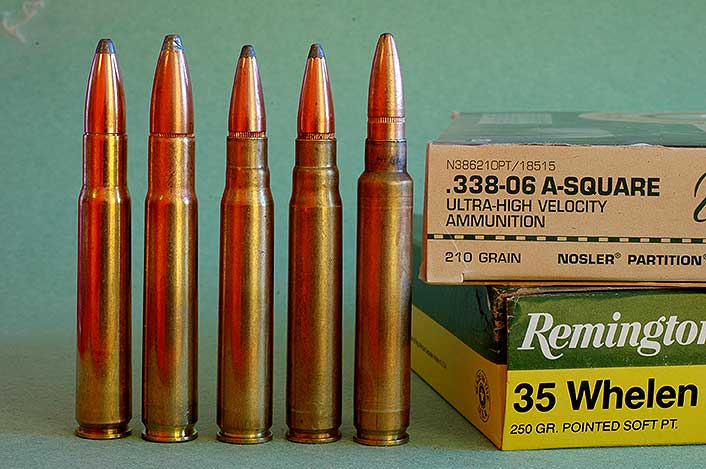
With the full-length Gibbs sizing die, I then necked all .338- and .358-diameter necks to .308 to form a new shoulder forward of the original. This neck-up-neck-down process is necessary, as headspace measure for the Gibbs round differs from that of the .30-06. Fire-forming unaltered .30-06 ammo in a .30 Gibbs chamber causes a condition of excessive headspace and is dangerous!
For the final, fire-forming step, I weighed mild 50-grain charges of IMR 4350 behind 165-grain bullets. Cases extracted without a hitch, the new shoulders perfectly formed where the false shoulders had been. The original shoulders remained only as bright rings on the case bodies. I ran 20 more hulls through the dies and, in a fit of exuberance, hiked powder charges to yield velocities 100 fps higher than those of a .30-06. No problem. These case-forming loads routinely shot into a minute of angle!
I next scrounged a variety of powders I thought might work well in the Gibbs with bullets of 150 to 180 grains. The attached chart shows some results.
I’m still experimenting with hunting loads in the .30 Gibbs. Come fall, that Springfield will return to the hunting trail. I can’t wait!
Sidebar: Headspace
WHEN YOU PULL a trigger, many important events happen fast. The striker’s blow crushes the face of the primer against the anvil inside, detonating the shock-sensitive priming mix pinched between them. Flame jets through the flash-hole in the primer pocket, igniting the gunpowder in the case to produce gas. The ductile brass case expands under gas pressure, ironing itself to the chamber wall as the bullet is thrust from the case into the bore. At the same time, gas pushes the case head against the bolt.
Peak gas pressure can exceed 30 tons per square inch. But the case doesn’t respond uniformly to it. The brass tapers, from thick at the web (brass around the flash-hole) to thin at the neck. As the front of the hull irons itself to the chamber up front, gas pressure has progressively less effect at the rear. The base of the hull just above the web remains near its original diameter.
Now, if the case is held tight to the bolt face, everything is OK. The case head simply absorbs the rearward thrust of gas without moving, as it is supported by the bolt face. But it’s unusual for an unfired cartridge to fit tight against the bolt face, because it would be hard to chamber – a press fit. A cartridge a tad too long would not chamber. So chambers are cut generously, to ensure all factory-loaded ammo will chamber. But too big a reach between the bolt face and the point in the chamber that stops forward motion of a cartridge causes a condition of excess headspace. That’s not good at all.
Headspace is the distance from the face of the locked bolt to a “datum line” in the chamber that arrests forward movement of the cartridge.
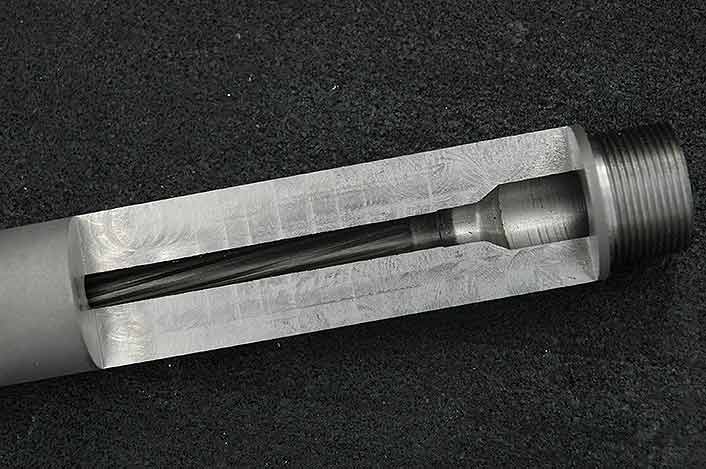
The striker’s blow pushes the cartridge forward until it contacts the datum point in the chamber. Case expansion sticks it there. The case head isn’t stuck because it is thick and doesn’t expand as much, so it moves rearward to meet the bolt face. The ductile brass case stretches – mainly just above the web. Excessvie headspace permits excessive stretching and case separation. Think of a rubber band pulled too far. Repeated firings “work harden” a case, reducing its ability to stretch. Think of an envelope clasp bent back and forth. When a hull splits, gas jets into the chamber faster than a bullet. It zips along the bolt race, through the striker hole, into the magazine well. It can find your eye faster than you can blink. To ensure against such catastrophe, use only ammunition that meets headspace tolerances in your chamber!
THE TERM “HEADSPACE” originated when all metallic cartridges had rims, so the first measurements were made only at the head. Headspace is still gauged from the bolt face, but the datum point varies with cartridge design. A straight rimless case (.45 ACP) headspaces at the mouth, because that’s what stops the round from going farther forward. On a belted magnum, the front edge of the belt serves the same purpose as the rim of a .30-30. The datum line for rimless bottleneck cartridges like the .30-06 is on the shoulder. Ditto for rebated cases (the .284). Semi-rimmed rounds theoretically headspace on the rim. Sometimes (as with the .38 Super Automatic) the rim is insufficient given action tolerances needed for sure function. The case mouth then serves as a secondary stop. The semi-rimmed .220 Swift has a more substantial lip; but most handloaders prefer to neck-size only, so after a first firing, the case headspaces on the shoulder.
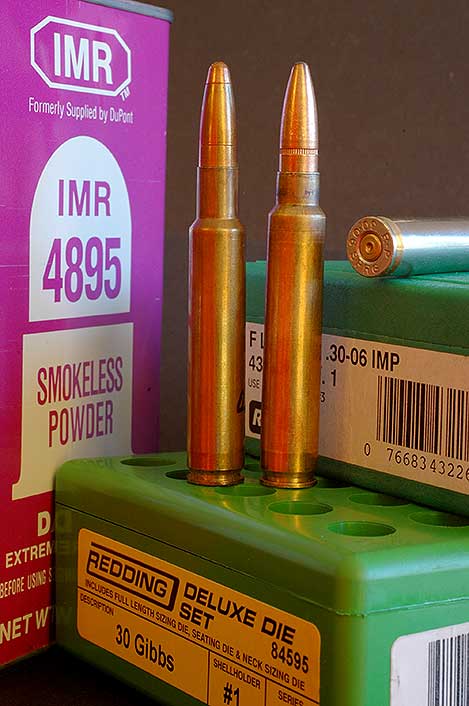
Gunsmiths measure headspace with steel “go” and “no go” gauges, inserted in the chamber. The “go” gauge is typically .004 to .006 shorter than the “no go” gauge for rimless and belted cartridges. The bolt should close on a “go” gauge, not on a “no go” gauge. Theoretically, if the bolt closes on a “no go” gauge, the barrel should be set back a thread, then rechambered to achieve proper headspace. However, some chambers that accept “no go” gauges may still serviceable with ordinary ammo. The “field” gauge, seldom seen now, has been used to check these chambers. It’s roughly .002 longer than a “no go” gauge.
If you’re handloading for only one bolt-action rifle, you’re smart to neck-size only, rather than full-length-size. The brass will move less with each firing, and last longer. Full-length sizing is necessary if you’re switching to a rifle with a slightly smaller chamber, and it helps ensure function in autoloading and lever- and slide-action rifles with anemic camming. Some hunters full-length-size all cases for a hunt, to guard against jams in adverse conditions.
Neck-sizing makes sense with belted cases, because chambers for them are often cut generously in the shoulder area. The critical dimension is the distance from bolt face to belt face (.220 to .224, “go” to “no go”). Full-length-sizing belted magnums, you reduce head-to-neck span considerably, so the hull stretches a lot at each firing. Eventually you’ll see a white ring around the case ahead of the belt. If you insert a wire with an “L” bend at the end, you may detect an indentation there – thinning of the case wall. Discard that hull!
Rechambering rifles to Improved cartridges should not alter headspace. That’s why you can fire factory ammo in an Improved chamber safely. Wildcat rounds with shoulders moved forward (the Gibbs series) must be fashioned in steps to prevent a condition of excess headspace.
Preliminary data, .30 Gibbs
These are not recommended loads! Rifle bores and chambers differ. Proceed with caution!
.30 Gibbs (case-forming) in 24-inch 03A3
Powder Bullet Velocity
59 H380 130 Speer HP 2940
63 WW 760 150 Hornady 2930
53 IMR 4064 150 Sierra 2927
62 IMR 4350 150 Hornady 2920
53 H380 165 Speer 2719
61 IMR 4350 165 Sierra 2815
61 WW 760 165 Speer 2855
64 RL-19 180 Pwr Point 2819
61 WW 760 180 Core-Lokt 2793
62 RL-19 180 Core-Lokt 2630
.30 Gibbs (fully formed) in 24-inch 03A3
58 Big Game 165 X (blue) 2830
62 WW 760 165 Hornady 2995
59 Hybd 100V 180 Kodiak Bd 2800
61 IMR 4350 180 Core-Lokt 2748
64 RL-19 180 A-Frame 2870
Wayne van Zwoll has published 16 books and roughly 3,000 magazine articles on firearms and hunting. Five of his most popular books are: Shooter’s Bible Guide to Rifle Ballistics ($20), Shooter’s Bible Guide to Handloading ($20), Mastering Mule Deer ($25), Mastering the Art of Long-Range Shooting ($30) and Gun Digest Shooter’s Guide to Rifles ($20). Limited numbers are available, autographed, from Wayne at 2610 Highland Drive, Bridgeport WA 98813. Please add $4 shipping.
Stay Connected
- Got a Break in the Montana Missouri Breaks
- It Took Six Days but We Finally Slipped One Past the Bears and Wolves
- No Mule Deer This Fall – Whitetail TOAD!
- An Accounting of Four Idaho Bulls (Elk)
- Arizona Deer Hunt 2019: Good Times with Great Guys
- Caught a Hornady 143 ELDX Last Night
- Cookie’s 2019 Mule Deer Photo Run
- Let’s See Some Really Big Deer
- Alaskan Moose Hunt Success!
- Take a Mauser Hunting: An Important Message From The Mauser Rescue Society!
- Welcome 16 Gauge Reloaders! Check In Here.
- Off-Hand Rifle Shooting – EXPERT Advice
- BOWHUNTING: A Wide One!

